
Sailing Saoirse
11 February 2014
11 February 2014 | Beagle Channel
08 February 2014
07 February 2014 | Between Piriapolis and Puerto Deseado
01 February 2014 | South Atlantic
21 January 2014 | South Atlantic
16 January 2014 | south atlantic
15 January 2014
15 January 2014
15 January 2014 | South Atlantic
09 January 2014
09 January 2014 | South Atlantic
07 January 2014 | Penticton BC Canada
06 January 2014 | South Atlantic
03 January 2014 | equator
31 December 2013 | almost South Atlantic
28 December 2013 | Atlantic
24 December 2013 | Atlantic
20 December 2013
20 December 2013 | Atlantic
Charlie at Work
22 September 2014 | Patagonia, Chile
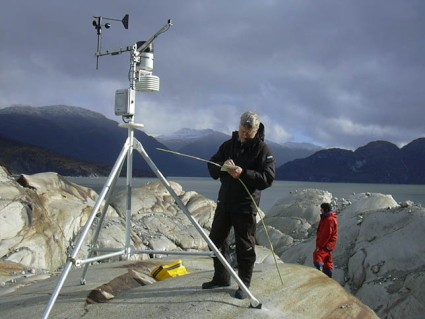
Photo (c) Carlos Olave
Mind the Weather
22 September 2014 | Puerto Wiliams,Chile
Keri
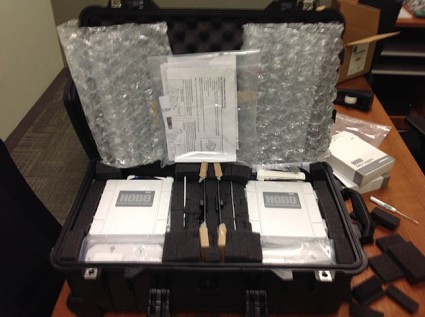
Photo (c) Gregg Daly
South Georgia & Charlie’s Hobo Weather Stations
In a few weeks time, we will be studiously scrutinizing the grib files and satellite images, looking for a favourable weather window for crossing the notoriously rough seas between the southern tip of South America and the Falkland Islands. In Port Stanley, we will be meeting our team that are joining us for a voyage to the Antarctic Island of South Georgia and once again, before departure for South Georgia, weather systems will be studied and the most suitable moment will be chosen to set sail on the next leg of our passage.
The weather in these regions is perhaps one of the most discussed topics between sailors, especially those of us in relatively small yachts. “Whoaaa! That was one big blow”, comments one wizened Captain after a hurricane force storm blows through, swiping the southern tip of the Falklands and pinning us against the dock in Stanley on our last trip there three years ago. Wind speeds of 100 knots were recorded at the airport, 80 knots and gusting at the dock. This all leaves one wondering, is this normal or are weather patterns changing?
How do we know the weather is changing? Who are the people investigating climate change and how are they doing this?
Well, here in our small sailing community in Puerto Williams, there was someone who was doing much more than their part towards knowledge of climate change. Charlie Porter was an eccentric American living in Chile for more than 30 years. He is best known for his rock climbing exploits (often solo) in places such as Yosemite and in Baffin Island, but here in Chile he was first a sailor, then a scientist. Using his sailing vessels Wild Pigeon, Gondwana, and then later on Ocean Tramp, Charlie sailed up and down the Chilean Patagonian Channels, combining his climbing skills with his insatiable curiosity and installing Hobo weather stations, time lapse cameras, sampling tree rings and studying anything else that might give an insight into the history of the climate and its global effects.
Charlie’s passion for knowledge drew him on several voyages to the Antarctic Island of South Georgia, where he installed three Hobo weather stations. These stations, along with the chain of stations he has installed along the coast of Patagonia, have been recording the wind, rain, humidity and radiant light now for over 13 years, the only coherent data records that currently exist for much of this area. Greg and I had a chance a number of years ago to make a few different voyages with Charlie, the most memorable when we volunteered to be mules to help him haul his ice coring equipment up onto the Patagonia Icecap near Seno Exmouth. This trip gave us a greater appreciation of his determination and dedication.
In February 2014, this all came to an abrupt end with Charlie’s unexpected passing. Not only did his death leave a huge void in the community here in Puerto Williams, but there was a risk that all the data he collected, and would have continued collecting, would be lost. Carlos Olave, a scientist working with CEQUA in Punta Arenas, along with climatologist Nicolas Buturovic from the Instituto de la Patagonia (Universidad de Magallenes), have been given the custody of Charlie’s data. Both Carlos and Nicolas have sailed with Charlie and co-authored papers on their findings bases on data collected from the weather stations. We now have the honour to be working with Nicolas and Carlos in the continuation of Charlies work. The first step in the new growth of this project is South Georgia, where we plan to access, maintain and upgrade the existing weather stations installed by Charlie. For this, we are very grateful to Onset Computer Corporation who have very generously donated 2 new complete Hobo weather stations for this.
South Georgia is just the beginning. Our goal, along with Carlos and Nicolas, is to keep going with the project here in Patagonia and to continue where Charlie left off.
South Georgia & Charlie’s Hobo Weather Stations
In a few weeks time, we will be studiously scrutinizing the grib files and satellite images, looking for a favourable weather window for crossing the notoriously rough seas between the southern tip of South America and the Falkland Islands. In Port Stanley, we will be meeting our team that are joining us for a voyage to the Antarctic Island of South Georgia and once again, before departure for South Georgia, weather systems will be studied and the most suitable moment will be chosen to set sail on the next leg of our passage.
The weather in these regions is perhaps one of the most discussed topics between sailors, especially those of us in relatively small yachts. “Whoaaa! That was one big blow”, comments one wizened Captain after a hurricane force storm blows through, swiping the southern tip of the Falklands and pinning us against the dock in Stanley on our last trip there three years ago. Wind speeds of 100 knots were recorded at the airport, 80 knots and gusting at the dock. This all leaves one wondering, is this normal or are weather patterns changing?
How do we know the weather is changing? Who are the people investigating climate change and how are they doing this?
Well, here in our small sailing community in Puerto Williams, there was someone who was doing much more than their part towards knowledge of climate change. Charlie Porter was an eccentric American living in Chile for more than 30 years. He is best known for his rock climbing exploits (often solo) in places such as Yosemite and in Baffin Island, but here in Chile he was first a sailor, then a scientist. Using his sailing vessels Wild Pigeon, Gondwana, and then later on Ocean Tramp, Charlie sailed up and down the Chilean Patagonian Channels, combining his climbing skills with his insatiable curiosity and installing Hobo weather stations, time lapse cameras, sampling tree rings and studying anything else that might give an insight into the history of the climate and its global effects.
Charlie’s passion for knowledge drew him on several voyages to the Antarctic Island of South Georgia, where he installed three Hobo weather stations. These stations, along with the chain of stations he has installed along the coast of Patagonia, have been recording the wind, rain, humidity and radiant light now for over 13 years, the only coherent data records that currently exist for much of this area. Greg and I had a chance a number of years ago to make a few different voyages with Charlie, the most memorable when we volunteered to be mules to help him haul his ice coring equipment up onto the Patagonia Icecap near Seno Exmouth. This trip gave us a greater appreciation of his determination and dedication.
In February 2014, this all came to an abrupt end with Charlie’s unexpected passing. Not only did his death leave a huge void in the community here in Puerto Williams, but there was a risk that all the data he collected, and would have continued collecting, would be lost. Carlos Olave, a scientist working with CEQUA in Punta Arenas, along with climatologist Nicolas Buturovic from the Instituto de la Patagonia (Universidad de Magallenes), have been given the custody of Charlie’s data. Both Carlos and Nicolas have sailed with Charlie and co-authored papers on their findings bases on data collected from the weather stations. We now have the honour to be working with Nicolas and Carlos in the continuation of Charlies work. The first step in the new growth of this project is South Georgia, where we plan to access, maintain and upgrade the existing weather stations installed by Charlie. For this, we are very grateful to Onset Computer Corporation who have very generously donated 2 new complete Hobo weather stations for this.
South Georgia is just the beginning. Our goal, along with Carlos and Nicolas, is to keep going with the project here in Patagonia and to continue where Charlie left off.
Yendegaia - Moving the Ranch
23 June 2014 | Caleta Ferrari, Yendegaia, Chile, Patagonia
Greg
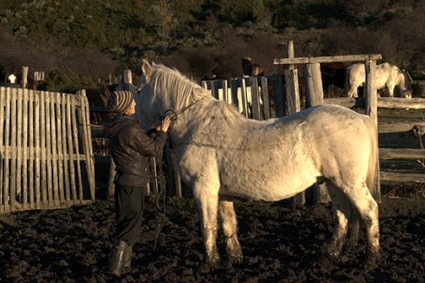
Well, so much for taking a break! Just as we go to tie up the lines to the Micalvi for a few weeks, we learn that our friend Annemie needs a bit of a hand with moving house. This will be no normal house moving party. She lives in the Yendegaia Valley, a large fiord 60 miles back west up the Beagle Channel.
"I just need a hand to move 65 horses and some things from the house to Puerto Natales" she says tiredly.
Right, shouldn't be too much of a problem. Annemie is a Belgian woman who fetched up on the Patagonian shores aboard a sailboat around 10 years ago. Finding that she preferred horse riding and the terrestrial life to sailing, she moved in with her gaucho partner Jose to the site of the old Estancia Yendegaia, some 20 miles west of Ushuaia, on the southern shore of Chilean Tierra del Fuego. Jose was working to clear this huge tract of land of feral cattle and wild horses for a group called Fundacion Yendegaia led by the controversial ecologist Doug Tompkins who wanted to bring the land back to its pristine condition. Recently though, the land has been donated to the government of Chile to be added to their extensive system of national parks which covers much of Tierra del Fuego. The trouble is that even after 10 years of subsistence living, a sudden severance with the land can have a major impact on ones life. Annemie and Jose had become used to capturing and training the wild horses which now roamed the old estancia, using these to round up the wild cattle which were keeping the land from regenerating into its wild condition. According to the terms of its new ownership though they now had to move on, leaving nothing of theirs behind.
On the night of the 31st, the regular passenger/freight ferry Yaghan was going to stop and load their belongings aboard and transport them all, first to Punta Arenas, then by road to Puerto Natales. Sixty five horses, many unbroken, eleven dogs and three half wild cats, a container load of equipment and memorabilia were to be loaded at midnight. Yaghan is a 220 ft roll-on roll-off ferry, even a close inspection of Yendegaia bay will reveal that there is not a dock in sight. This was going to be interesting.
Annemie waved her hand toward the place where the ferry was to arrive: a rocky shore about half a mile across from the estancia buildings where some deep water lapped against the rocky coast and I spent the afternoon ferrying the stuff across the flooded tidal flats to the far shore. The cats were the last to go in their hastily constructed cages and some parallel red markings on Annemies hands indicated that they clearly were not interested in leaving. Nevertheless, we spent the last hours of the night huddled around a small campfire with Annemie and the group of Chilean gauchos and fishermen, horses nickering nervously and dogs barking into the freezing dark.
Right on time the Yaghan comes steaming up the fiord, its powerful spotlights illuminating the whole wild scene, and manoeuvres its bow to press against the rocks, powerful engines pushing to maintain grip as she lowers her bow to the shore. Under the bemused gaze of the passengers, some even helping, first the goods and then the horses are persuaded aboard. It is a melancholy scene, part of the end of an era. It will be a long time before the last of the wild horses are rounded up and dispatched from Yendegaia, but we will miss them. Even though they are arguably not a natural part of the landscape here, they have been an integral part of the land usage since Europeans arrived. It will be a long time before the grand vision of a new national park will come to fruition here but one thing is for certain, the coming of the road from the north will forever change how we access and use the remote western half of Tierra del Fuego.
"I just need a hand to move 65 horses and some things from the house to Puerto Natales" she says tiredly.
Right, shouldn't be too much of a problem. Annemie is a Belgian woman who fetched up on the Patagonian shores aboard a sailboat around 10 years ago. Finding that she preferred horse riding and the terrestrial life to sailing, she moved in with her gaucho partner Jose to the site of the old Estancia Yendegaia, some 20 miles west of Ushuaia, on the southern shore of Chilean Tierra del Fuego. Jose was working to clear this huge tract of land of feral cattle and wild horses for a group called Fundacion Yendegaia led by the controversial ecologist Doug Tompkins who wanted to bring the land back to its pristine condition. Recently though, the land has been donated to the government of Chile to be added to their extensive system of national parks which covers much of Tierra del Fuego. The trouble is that even after 10 years of subsistence living, a sudden severance with the land can have a major impact on ones life. Annemie and Jose had become used to capturing and training the wild horses which now roamed the old estancia, using these to round up the wild cattle which were keeping the land from regenerating into its wild condition. According to the terms of its new ownership though they now had to move on, leaving nothing of theirs behind.
On the night of the 31st, the regular passenger/freight ferry Yaghan was going to stop and load their belongings aboard and transport them all, first to Punta Arenas, then by road to Puerto Natales. Sixty five horses, many unbroken, eleven dogs and three half wild cats, a container load of equipment and memorabilia were to be loaded at midnight. Yaghan is a 220 ft roll-on roll-off ferry, even a close inspection of Yendegaia bay will reveal that there is not a dock in sight. This was going to be interesting.
Annemie waved her hand toward the place where the ferry was to arrive: a rocky shore about half a mile across from the estancia buildings where some deep water lapped against the rocky coast and I spent the afternoon ferrying the stuff across the flooded tidal flats to the far shore. The cats were the last to go in their hastily constructed cages and some parallel red markings on Annemies hands indicated that they clearly were not interested in leaving. Nevertheless, we spent the last hours of the night huddled around a small campfire with Annemie and the group of Chilean gauchos and fishermen, horses nickering nervously and dogs barking into the freezing dark.
Right on time the Yaghan comes steaming up the fiord, its powerful spotlights illuminating the whole wild scene, and manoeuvres its bow to press against the rocks, powerful engines pushing to maintain grip as she lowers her bow to the shore. Under the bemused gaze of the passengers, some even helping, first the goods and then the horses are persuaded aboard. It is a melancholy scene, part of the end of an era. It will be a long time before the last of the wild horses are rounded up and dispatched from Yendegaia, but we will miss them. Even though they are arguably not a natural part of the landscape here, they have been an integral part of the land usage since Europeans arrived. It will be a long time before the grand vision of a new national park will come to fruition here but one thing is for certain, the coming of the road from the north will forever change how we access and use the remote western half of Tierra del Fuego.
PUERTO WILLIAMS
16 June 2014 | 80 miles from Cape Horn as the Albatross Flies
Greg
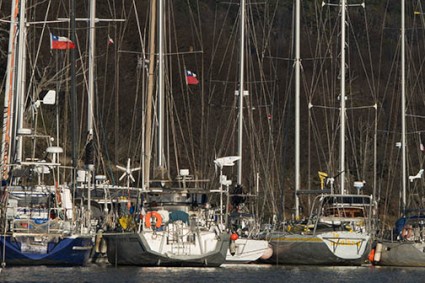
Photo: Entangled for the Winter - Keri Pashuk
20th May.
This has been a huge year. Since we bought Saoirse in Greenland last August, she has sailed nearly 17,000 miles, meanwhile supporting four expeditions from the Canadian Arctic to Patagonia. This just after she completed a major expedition (as "Explorer of Sweden") on the west coast of Greenland searching for the wreck of the Vega (the first ship to transit the Northeast Passage under Adolf Erik Nordeskjold) with her previous owner Ola Skinnarmo. There has hardly been time to come up for air and certainly it is time to take a bit of a break and decide where it is that we go from here. At this time of year the sun vouchsafes to appear over the mountains for only a few hours a day, the blood flows sluggishly in the veins and Puerto Williams, though full of boats, is once again dormant after the frenetic activity of the summer months. Very few of the boat owners stay here over the winter, most return to enjoy the northern summer in their home countries. We will take some time to put right all those niggly little things that gang up on one over the season and there is never time to fix properly.
It is also great to come back to see our other vessel Northanger again (see www.northanger.org) also nestled snugly up against the Micalvi, the sunken Chilean supply vessel which now famously serves as the worlds southernmost yacht club.
20th May.
This has been a huge year. Since we bought Saoirse in Greenland last August, she has sailed nearly 17,000 miles, meanwhile supporting four expeditions from the Canadian Arctic to Patagonia. This just after she completed a major expedition (as "Explorer of Sweden") on the west coast of Greenland searching for the wreck of the Vega (the first ship to transit the Northeast Passage under Adolf Erik Nordeskjold) with her previous owner Ola Skinnarmo. There has hardly been time to come up for air and certainly it is time to take a bit of a break and decide where it is that we go from here. At this time of year the sun vouchsafes to appear over the mountains for only a few hours a day, the blood flows sluggishly in the veins and Puerto Williams, though full of boats, is once again dormant after the frenetic activity of the summer months. Very few of the boat owners stay here over the winter, most return to enjoy the northern summer in their home countries. We will take some time to put right all those niggly little things that gang up on one over the season and there is never time to fix properly.
It is also great to come back to see our other vessel Northanger again (see www.northanger.org) also nestled snugly up against the Micalvi, the sunken Chilean supply vessel which now famously serves as the worlds southernmost yacht club.
FILMING FOR THE PEARL BUTTON
09 June 2014 | Seno Pia, Beagle Channel, Chile
Keri
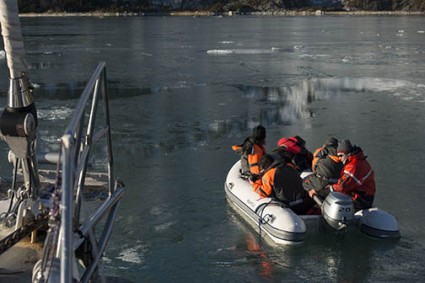
The film team and Greg breaking way through the frozen sea ice as they head out to get some glacier images.
THE PEARL BUTTON - A VIDEOGRAPHIC OUTING
09 June 2014 | Beagle Channel, Chile
Greg
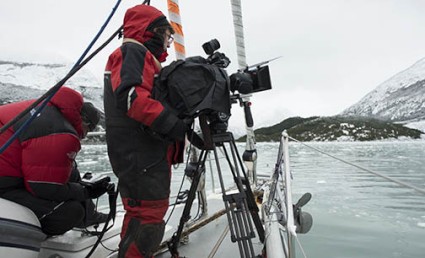
Photo by Keri-Lee Pashuk
Two years ago we took a ten-day trip excursion to the end of Seno Almirantazgo as a scouting mission for a new documentary movie by a Chilean-French film director, Patricio Guzman. Fleeing Chile at the beginning of the military regime, Patricio's films have deep roots in the Chilean psyche, so we were intrigued by the opportunity to partake in this production.
His most recent film, Nostalgia de la Luz, is a search for the past, artfully juxtaposing various recent and ancient happenings in the Atacama Desert. On the one hand he shows the desperate plight of the incomplete families who still search the dry sands of the Atacama Desert for their loved ones who disappeared during the coup. On the other hand he brings forth a more hopeful search by Chilean astronomers who depend on the purity of the arid desert air to aid in their search for the secrets of history closely following the "Big Bang". This new film, intriguingly called "The Pearl Button" will be it's southern sequel.
We are spending ten days sailing down through the labyrinth of channels between Punta Arenas and Puerto Williams with him and his team on the quest for a new story. From what we know of it, this part of the story will focus on the quality of the light as it reflects from the water during storm and calm. For us, this is familiar territory, but it is always rewarding to be involved with people who have a different and unique perspective on what they are seeing and experiencing, and how they relate it to the story they want to tell.
We leave Puerto del Hambre (where the first colonists of the south starved to death in short order) and head down past Cabo Froward, passing the normally fierce Strait of Magellan in dead calm conditions. Fresh from Paris, the video team abandon the dire warnings of their colleagues who have filled them with cautionary tales full of dread. Alvaro waves his microphone at anything that might be capable of making a noise, while Katell points her video camera at the huge visual feast which passes before us. The light of the sun disappears so quickly here at this time of year, but this is made up for by its low angle and stunning pastel colors which it wrests from the landscape. Patricio, morbidly afraid of sailing, is glued to his monitor, while his assistant Nicolas collects supporting footage on the production's other cameras. Through all of this, Saoirse ambles her way down toward the Beagle Channel, through the Southern light and hopefully to a well deserved rest in Puerto Williams.
A couple of days out the wind has turned to the south west and the usual post-frontal squally weather ensues painting all of the mountains white. Horizontal sleet, interspersed with bright, strong sun; this is photography weather and we attempt to get the heavy camera and its tripod onto land as much as possible to capture the wildly swinging moods of the landscape. There is no better place for this in the world than Caleta Brecknock with its sombre rock towers catching the weather and hurling it seawards. Katell and Patricio spend many cold hours behind the lens here but are rewarded with some superb footage which will form the backdrop of their movie.
Clearing weather and a welcome high pressure system has us scuttling back west to the Northwest Arm of the Beagle Channel and though the channels are still snow-white, the calm weather gives them a chance to capture the grandiose sweep of the tidewater glaciers; the subtle detail reflected in the water and the rise of the full moon on the same day.
Two years ago we took a ten-day trip excursion to the end of Seno Almirantazgo as a scouting mission for a new documentary movie by a Chilean-French film director, Patricio Guzman. Fleeing Chile at the beginning of the military regime, Patricio's films have deep roots in the Chilean psyche, so we were intrigued by the opportunity to partake in this production.
His most recent film, Nostalgia de la Luz, is a search for the past, artfully juxtaposing various recent and ancient happenings in the Atacama Desert. On the one hand he shows the desperate plight of the incomplete families who still search the dry sands of the Atacama Desert for their loved ones who disappeared during the coup. On the other hand he brings forth a more hopeful search by Chilean astronomers who depend on the purity of the arid desert air to aid in their search for the secrets of history closely following the "Big Bang". This new film, intriguingly called "The Pearl Button" will be it's southern sequel.
We are spending ten days sailing down through the labyrinth of channels between Punta Arenas and Puerto Williams with him and his team on the quest for a new story. From what we know of it, this part of the story will focus on the quality of the light as it reflects from the water during storm and calm. For us, this is familiar territory, but it is always rewarding to be involved with people who have a different and unique perspective on what they are seeing and experiencing, and how they relate it to the story they want to tell.
We leave Puerto del Hambre (where the first colonists of the south starved to death in short order) and head down past Cabo Froward, passing the normally fierce Strait of Magellan in dead calm conditions. Fresh from Paris, the video team abandon the dire warnings of their colleagues who have filled them with cautionary tales full of dread. Alvaro waves his microphone at anything that might be capable of making a noise, while Katell points her video camera at the huge visual feast which passes before us. The light of the sun disappears so quickly here at this time of year, but this is made up for by its low angle and stunning pastel colors which it wrests from the landscape. Patricio, morbidly afraid of sailing, is glued to his monitor, while his assistant Nicolas collects supporting footage on the production's other cameras. Through all of this, Saoirse ambles her way down toward the Beagle Channel, through the Southern light and hopefully to a well deserved rest in Puerto Williams.
A couple of days out the wind has turned to the south west and the usual post-frontal squally weather ensues painting all of the mountains white. Horizontal sleet, interspersed with bright, strong sun; this is photography weather and we attempt to get the heavy camera and its tripod onto land as much as possible to capture the wildly swinging moods of the landscape. There is no better place for this in the world than Caleta Brecknock with its sombre rock towers catching the weather and hurling it seawards. Katell and Patricio spend many cold hours behind the lens here but are rewarded with some superb footage which will form the backdrop of their movie.
Clearing weather and a welcome high pressure system has us scuttling back west to the Northwest Arm of the Beagle Channel and though the channels are still snow-white, the calm weather gives them a chance to capture the grandiose sweep of the tidewater glaciers; the subtle detail reflected in the water and the rise of the full moon on the same day.
| Vessel Name: | Saoirse |
| Vessel Make/Model: | Ralph Modig Desgin built by Alve Henriksen in Sweden |
| Hailing Port: | Wellington, New Zealand |
| Crew: | Greg Landreth and Keri Pashuk |
| About: | Keri and Greg, owners of the Damien II sailing vessel, Northanger, are bringing Saoirse south for Science, Education and Adventure. They are please to have had the help of volunteer Sarah Schwimmer who joined us in Chacabuco, Chile. |
Gallery not available
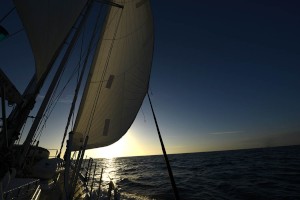
Who: Greg Landreth and Keri Pashuk
Port: Wellington, New Zealand